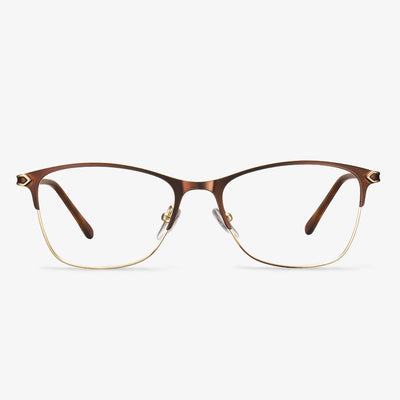Where to Buy Anti-Reflective Glasses?
From the above, you have learned some benefits of anti-reflective glasses. You may ask where I can buy them. To do that, you can buy them from the local optical store. But now, you can buy them online and it can bring you great convenience.
So, if you want to buy anti-reflective glasses online, Koalaeye Optical is recommended. It provides all kinds of eyeglasses, sunglasses, and frames. What’s more, Koalaeye Optical provides a free shipping service so that the package will be mailed for you with your great convenience.
Choose clear glasses for kids of suitable temples and nose pads.
Children's head is very different from adults, especially the height of the bridge of the nose. Most children's bridge of the nose is low. Therefore, it is best to choose a high nose pad for children's glasses or an adjustable eyeglass frame for the nose pad. The temples of the glasses should not cause uncomfortable pressure and the glasses should be kept in the correct position. Sporty temples are another option. The temples are very flexible, and they fit well into a child's ear. It should extend to the earlobe and be covered with soft plastic.
Leimi Driving Glasses
With professional production and sales of sunglasses/flat glasses/sunglasses, Leimi has been focusing on the fashion aesthetics of sculpted glasses. They are presented through the exquisite selection of materials and fashionable and comfortable design. Leimi carefully makes glasses and discovers the beauty of the world together. Leimi advocates for consumers to experience the number of products through the exquisite materials and fashionable and comfortable design of various glasses products. Leimi believes that it can impress consumers with its products. Since its establishment, Leimi has always been striving to treat customers with high-quality products and good service. At present, Leimi's main products are swimming goggles, reading glasses, sunglasses, lenses, anti-radiation glasses, sunglasses for women, children's glasses, glasses frames, polaroid glasses, driver's glasses.
The style of prescription glasses
Choose the material, and then choose the style. The width of the appropriate frame should match the distance between the two pupils to ensure that the eye can pass through the optical center when looking at things. Choose the right style according to your face shape. Generally follow the complementarity principle, such as choosing square frames for round faces and round frames for square faces. After choosing the frame, you should try it on for a while to see if the weight is appropriate and the style is suitable.
The design evolution of progressive lenses
Spherical and aspheric designs
The design of the front surface of the far-use area of the early progressive lens is similar to that of the ordinary spherical single vision lenses, so it is called a spherical progressive lens. Since 1974, the front surface of the far-use region of the lens is designed to be aspheric by designers, which not only reduces the peripheral aberration but makes the lens thinner, lighter, and less powerful.
Hard and soft design
For hard design, the channel is short, and the gradient is large. The near-use area position is high. The effective visual area of remote and near-use areas was larger. Peripheral astigmatism is relatively concentrated. Because surrounding astigmatism increases rapidly and the distribution is dense, the curve effect is more obvious. The gradient area is narrow. It is more difficult and takes longer for wearers to adapt.
Lenses with soft designs have slower gradients, longer gradients, and wider gradients. The angle of rotation of the eye from the far area to the near area is greater. It's easier to get used to. Compared with the hard design, the effective visual area of the far and near use areas is smaller, and the location of the near use area is lower.
Single, diverse, and individualized design
Initially, the progressive lenses used a single design, in which each basic curve was scaled equally and a luminosity combination was added within the range of its semi-finished lens blanks. The steepest base curve uses the same lens design as the flattest base curve. Lenses designers quickly realized that the overall performance of the lens could be improved by microcustomizing the lens design, leading to progressive lenses with multiple designs. This kind of design is called diverse design. By the mid-1990s, there was the emergence of individualized lens designs. In addition to using different gradients, these first individualized lens designs used steeper baseline curves with a slightly larger approach area to compensate for increased magnification and reduced field of view.
Symmetrical and asymmetric design
There is no difference between the left and right eyes in the symmetrical design of progressive lenses. As the eyes turn inward when they see near objects, the gradual gradient area gradually tilts to the nasal side from top to bottom, so the left/right progressive lenses should be rotated clockwise/counterclockwise respectively during processing. An asymptotic lens with left and right eye divisions is called an asymmetric design. The gradient is gradually and moderately inclined to the nasal side from top to bottom. The refractive force, astigmatism, and vertical prism of the two sides of the left and right gradient of the asymmetric design lenses are basically similar. At the same time, considering the characteristics of eye movement parameters in binocular vision, the peripheral aberrations of the corresponding positions of the left and right lenses were appropriately balanced to improve the visual effect of the wearer.
Can't Use Alcohol To Clean Glasses
Generally speaking, alcohol is not suitable for cleaning resin lenses. Resin lenses are relatively soft and are usually coated with a film. It not only improves the hardness of the lens, but also has more other functions. The lens film is not suitable for cleaning with harsh cleaning agents. As we all know, alcohol has a certain stimulating effect, so it is harmful to the film of the lens.
Progressive lenses and single vision lenses
Single vision lenses are the most widely used optical lenses and are suitable for the general population.
Progressive lenses are suitable for below people.
① Myopia control lenses for teenagers. Progressive lenses are used to relieve visual fatigue and control the development speed of myopia.
② Anti-fatigue lenses for adults. Progressive lenses are used for teachers, doctors, people who use too much computer at close range to reduce visual fatigue caused by work.
③ Progressive lenses for Middle-aged and elderly people. A pair of glasses for middle-aged and elderly people to easily see near and far.











































